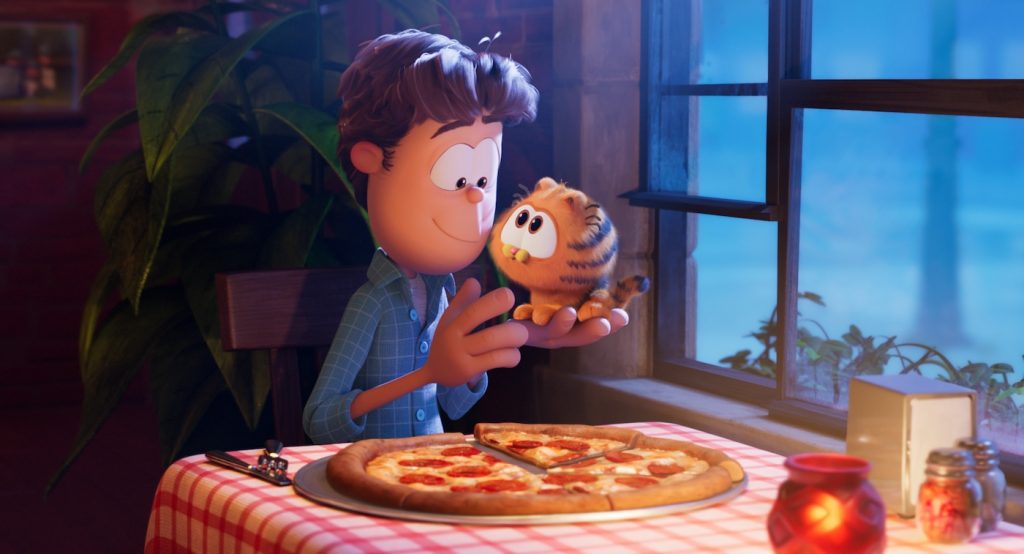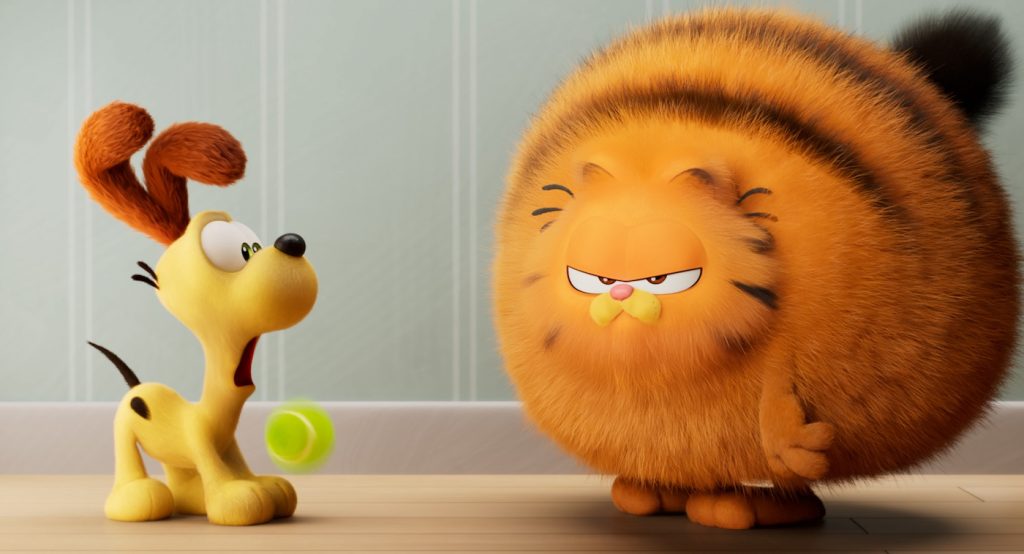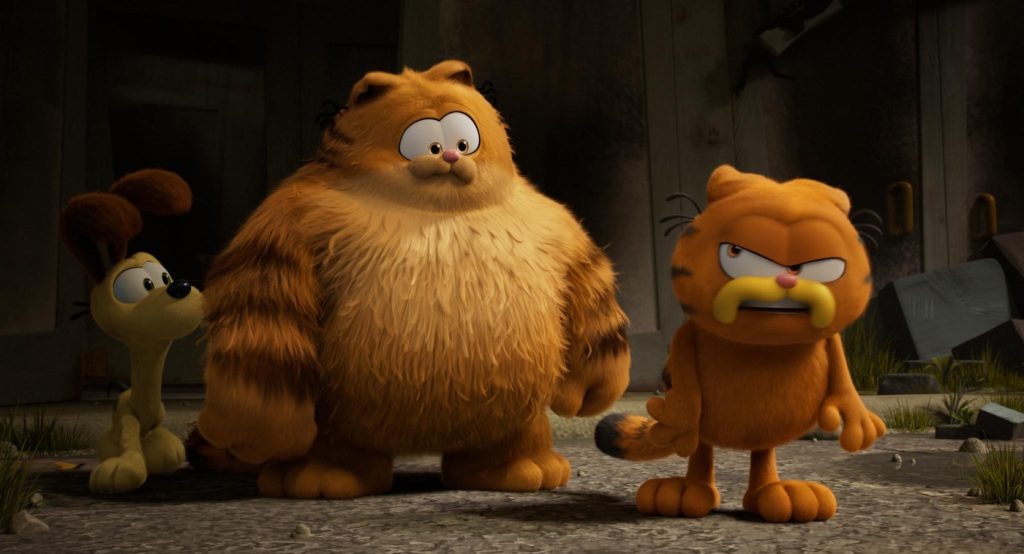Animation Director Jason Boose on Creating a Madcap “Garfield” for a New Generation
Chris Pratt voices the iconic, lasagna-loving star of director Mark Dindal’s The Garfield Movie, which uses Garfield’s love of Italian cuisine and the indoors as a jumping-off point for an origin and adventure story in one. A sweet-faced kitten gloms onto lonely Jon (Nicholas Hoult) at a restaurant and doesn’t let go until an unexpected reunion with his father, Vic (Samuel L. Jackson).

This father-son reunion comes on the heels of a catnapping, bringing reluctant Garfield into the fold of a heist led by a vengeful Persian cat named Jinx (Hannah Waddingham). The booty at stake is a truck full of milk Jinx feels she’s owed, and to get it, Garfield, his dad, and Odie (Harvey Guillén) wind up freight-hopping and breaking into a maximum-security dairy farm. Obviously, this is a far cry from Garfield’s preferred station, at Jon’s dining table or in front of the television, and calls for a new approach to animating the classic character. Animation director Jason Boose (The Little Prince, Up), along with a team of 70 to 80 animators spread across the globe, translated Garfield’s signature deadpan existence into the more madcap one we see here. Dindal wanted the team to be bold as they figured out what worked and what didn’t, so we spoke with Boose about working to avoid cliche while both expanding Garfield’s range while keeping aspects of his withering reluctance intact.
Were you a fan of Garfield going into the film?
It wasn’t until I was working on the movie that I remembered I loved the character so much. I was researching it, watching the specials from the 80s, and reading the comics; a lot of it was so familiar. I was halfway through the film, my parents were moving out of their house, and they wanted me to go through my stuff from when I was a kid. I was looking through some old sketchbooks, and there were all kinds of drawings of Garfield from the comic strips. It was serendipitous, in a way. I loved the character then, and I love it now. Looking at the drawings again, you realize the comic strip was drawn with such skill. It’s funny, it’s charming, it’s still relevant today.

Given that, what did you want to ensure you retained from the original strip?
The jumping-off point was tricky because all of us in the film wanted to honor Jim Davis and his creativity. I think it’s the most syndicated comic strip ever, so it’s loved worldwide. You have to honor how it’s done, but at the same time, you have to give the audience something new and reinvent it for a new generation. Garfield is sometimes quite sweet in the comic, in unexpected ways, but he’s also quite cynical and sarcastic. We have to be able to honor the original character but also show a broad range of emotions. That’s the trick of it all.
Was there ever a question of how much to push his facial expressions?
At first, we would try to match what Jim Davis was doing, to make sure we could hit those poses — the completely sarcastic, deadpan eyes and the sardonic grin. Then, we had to go through many more expressions and ranges of emotion. That’s tricky because CG doesn’t want to go as far as some of the drawings Jim Davis did. Sometimes you’re going from regular, deadpan Garfield, who we recognize, [to him] eating a piece of cake. His whole mouth becomes absolutely massive, his eyes disappear, his ears disappear, and he’s all mouth and muzzle, and in CG, that’s a completely different model. We were almost switching from one model to a new model over one frame to try to get these exaggerated poses and do it quickly enough so the audience didn’t notice. And because you’re doing dialogue and a huge range of emotion, there are a lot of expressions that were obviously never drawn in the original comic strip. That unique muzzle of Garfield’s was a real challenge to get into all different shapes.
How did you develop baby Garfield? He’s very cute, but he also has to carry a lot of emotional weight.
We went for pure innocence. He evolved. He started off as a very small part of the film, and he was loved so much that he expanded more and more. We just wanted to play him so sweet. We wanted everyone to absolutely love him, recognize that that is Garfield as a baby, and have their hearts break for him.
How did you develop the look of new characters, like Vic and Jinx?
The voice acting was so incredible. With Jinx, for example, and Hannah Waddingham, you have the character design, you have that vocal performance, and then you have what Mark wanted to create with that character. And Norma Desmond, from Sunset Boulevard, was an inspiration. So it was taking [all that] and trying to inject that into a big fluffy white cat. We didn’t want to animate a typical diva because she’s a very unique character. Everything she does, we wanted to make somewhat unexpected and unusual. Every shot we looked at, we looked at through that lens. Vic is very Samuel L. Jackson. He just gets so much from the cadence of his vocal performance. The way he delivers a line, both visually and auditorially. We tried to honor him as much as we could and get as much of him into Vic as we could.

How did you develop the backgrounds? Some are tangible; some are more painterly.
Pete Oswald and Jeanie Chang did the production design and art direction. Through Mark Dindal’s direction, they wanted to create a very painterly world, very warmly lit, with a lot of backlit characters. The biggest thing they wanted to get across was a feeling of miniature. Mark almost wanted it to feel like the Viewmasters from the 70s and 80s. You hold them up, look through them, and everything looks a bit miniature. That was his initial inspiration for the movie, was to try and give it that sort of charm and feel.
How did you settle on which animation styles to use in the film?
We wanted to let the story and performance dictate the style of animation, which is unique in a way. Some parts of the film are quite touching and heartfelt, so it calls for a much more naturalistic style of animation, much more believable. But some parts of the film are completely wacky and crazy, and it goes much more Chuck Jones/Tex Avery style, where anything can happen. Sometimes it’s somewhere in between. We were always weaving between those different animation styles and trying to weave them together seamlessly.
Garfield is in theaters now.
For more upcoming films from Sony Pictures, check out these stories:
“The Garfield Movie” Director Mark Dindal on Taking a Famously Lazy Indoor Cat Way Outdoors
Danny Boyle’s “28 Years Later” Casts Jodie Comer, Aaron Taylor-Johnson and Ralph Fiennes
Tom Holland Slings a Hopeful “Spider-Man 4” Update
Featured image: Vic (Samuel L. Jackson) and Garfield (Chris Pratt) in GARFIELD. Courtesy Sony Pictures.



